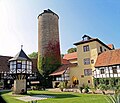Westerburg Castle
| Westerburg Castle | ||
|---|---|---|
|
Westerburg near Dedeleben |
||
| Castle type : | Niederungsburg | |
| Conservation status: | Received or received substantial parts | |
| Place: | Huy -Westerburg | |
| Geographical location | 52 ° 0 '51 " N , 10 ° 51' 58" E | |
|
|
||
The Castle Westerburg is located in the district of the town of Westerburg Huy (west of the district Dedeleben ) in Saxony-Anhalt . The complex is on the Romanesque Road . It is considered the oldest preserved moated castle in Germany. The castle can also be reached via the 80 km long cycle path through the old district of Halberstadt .
history
The history of the plant is not known. It is located on an early, paved path through the swampy lowland of the Great Break . In the area of a 350 × 300 m ring wall with a moat, an oval round castle measuring 60 × 80 m with a round keep was inserted.
Around 1180, the Regenstein counts received the castle as a fief and built it up into one of their strongest fortresses. During this time, it was converted into a residential complex, with the circular wall with a thickness of up to 1.95 meters also forming the outer wall of the houses.
Two more women from Rohrsheim were burned in witch trials on July 14, 1596 and three more women from Rohrsheim on May 12, 1597 at the instigation of the bailiff Peregrinus Hünerkopf. Katharina Bernburg fled to Wernigerode , but was convicted of alleged witchcraft there .
After the death of the last Regenstein count, the castle fell under Halberstadt administrative law again. In the course of the following centuries, the owners of the old fortress changed frequently:
- In 1599, after the Regensteiners died out, Westerburg fell back to the Bishop of Halberstadt, Duke Julius of Braunschweig ; various lendings and pledges
- In 1630, Swedish troops occupied the castle in the Thirty Years War, but there was no destruction.
- In 1648 the Diocese of Halberstadt and with it the Westerburg came to Kurbrandenburg .
- 1681 Completion of the baroque castle chapel under Henning Adolph von Steinberg and Anna Catharina von Münchhausen
- In 1701, after several changes of ownership, alterations and structural additions, Prussian princes ( Friedrich I. , Friedrich II. , Heinrich Ludwig ) were the owners of what was now the Westerburg domain.
- 1770 Lease of the castle to Georg Wilhelm Wahnschaffe with the condition that the boggy “Große Bruch” be reclaimed.
- In 1802 it became the Prussian state domain .
- In 1952 it served the LPG Westerburg as the administrative headquarters with stables, apartments and a small restaurant.
- 1990 Lease, maintenance, restaurant operation
- 1999 sale by TLG to private owners; extensive renovation and conversion to a hotel
- July 2nd, 2000 opening as a 4-star superior hotel with restaurant
investment
To this day, two circumferential moats with a wall in between have been preserved. The inner moat encloses the oldest castle, an oval structure with a diameter of about 70 m, in whose wall ring in the southwest the 33 m high keep is integrated. This has a circular floor plan and its entrance is 12 m high. To the west there is a 34 m long fort-like extension with a small inner courtyard. Conversions in the fort area were mainly carried out in the Renaissance , which can be seen particularly in the windows and portals. There is also a wooden pulpit altar in the castle chapel from the end of the 17th century. The decoration, dated "1681" but unsigned, is attributed to Martin Kraft. Also worth seeing are the count's office, the Princess Marie Pauline restaurant, the knight's cellar, the prince and mirror hall, the baroque palace chapel and the keep.
gallery
literature
- Reinhard Schmitt : The Westerburg (large architectural monuments; Bd. 453). 2nd edition Deutscher Kunstverlag, Munich 1995.
- Ewald Seyffarth: The families of Westerburg compiled from the church book 1673–1777 of the Evangelical Community of Rohrsheim . Rhoden 1968. 167 families, according to inventory part IV of the German Central Office for Genealogy , p. 528
- Ewald Seyffarth and Gerhard Reiche : Family book. The families of Westerburg. Copy of the manuscript . Osterwieck 1982. 625 families in the period 1673–1982, according to the inventory, part IV of the German Central Office for Genealogy , p. 528
Web links
- History of the Westerburg
- Description of the castle in the Braunschweig-Ostfalen region
- Westerburg Castle on burgenwelt.de
- Romanesque Hotel Wasserschloss Westerburg
- Moated castle Westerburg in 130 photos
- the Westerburg at Welt-der-Wappen: description and photos, focus on heraldry
Individual evidence
- ↑ Bettina Seyderhelm (Ed.): Baptism angel in Central Germany. Regensburg 2009, p. 56 f.










